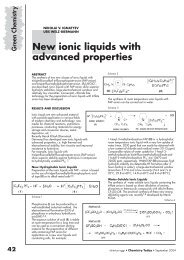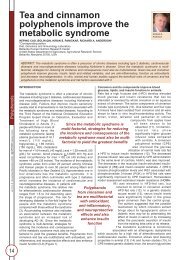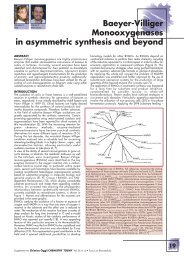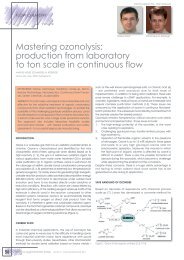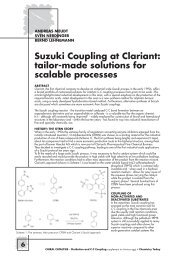New developments and findings - CHIMICA OGGI/Chemistry Today
New developments and findings - CHIMICA OGGI/Chemistry Today
New developments and findings - CHIMICA OGGI/Chemistry Today
You also want an ePaper? Increase the reach of your titles
YUMPU automatically turns print PDFs into web optimized ePapers that Google loves.
Matteo Z<strong>and</strong>a<br />
FOCUS ON FLUORINE CHEMISTRY<br />
The trifluoroethylamine function<br />
as peptide bond replacement<br />
<strong>New</strong> <strong>developments</strong> <strong>and</strong> <strong>findings</strong><br />
SERENA BIGOTTI 1 , FRANCESCA OLIMPIERI 1 , SREEJITH SHANKAR P. 1 ,<br />
GIOVANNI PINNA 1 , STEFANO ALTOMONTE 1 , MATTEO ZANDA 1,2 *<br />
*Corresponding author<br />
1. C.N.R. – Istituto di Chimica del Riconoscimento Molecolare, <strong>and</strong> Dipartimento di Chimica<br />
Materiali ed Ingegneria Chimica “G. Natta” del Politecnico di Milano, via Mancinelli 7, Milano, I-20131, Italy<br />
2. Institute of Medical Sciences, University of Aberdeen, Foresterhill, Aberdeen, AB25 2ZD, Scotl<strong>and</strong>, United Kingdom<br />
ABSTRACT<br />
T h e x e n o b i o t i c<br />
trifluoroethylamine peptide<br />
bond replacement is keeping up the pace as an<br />
important new option in the arena of drug discovery.<br />
Recent <strong>developments</strong> <strong>and</strong> <strong>findings</strong> are highlighted herein.<br />
introduction<br />
Peptide drugs are generally more expensive to<br />
synthesize <strong>and</strong> less stable than small molecule drugs.<br />
Moreover, due to their low bioavailability, which in turn is<br />
due to rapid hydrolysis by endogenous proteases,<br />
peptides clear faster from the body <strong>and</strong> usually need to<br />
be injected rather than swallowed as a pill. However, they<br />
can be much more potent than small molecules, show<br />
higher specificity, have fewer toxicology problems, don’t<br />
accumulate in organs or face drug-drug interaction<br />
challenges that affect small molecules (1). For these<br />
reasons, the design <strong>and</strong> synthesis of metabolically stable<br />
peptide analogs that can either mimic or block the<br />
bioactivity of natural peptides or enzymes is an important<br />
area of medicinal chemistry <strong>and</strong> drug discovery. Isosteric<br />
replacement of a scissile peptide bond represents a<br />
viable <strong>and</strong> popular approach in the rational design of<br />
peptide mimics <strong>and</strong> surrogates. Indeed, many<br />
therapeutically useful peptidomimetics incorporating any<br />
of the peptide isosteres that are currently available have<br />
been described (2).<br />
the trifluoroethylamine function<br />
Many amide replacements are known which retain the<br />
geometry of the amide bond or maintain the<br />
hydrogen bond-accepting properties of the amide.<br />
However, only a few functional groups, which are capable<br />
of preserving the hydrogen bond-donating properties of<br />
the amide have been described. Among them, one can<br />
mention sulfonamides, anilines, secondary alcohols,<br />
hydrazines, <strong>and</strong> certain heterocycles. The main issue for<br />
identifying a truly effective NH amide replacement can be<br />
recast as how to minimize the basicity of an NH donor so<br />
that a NH +<br />
2 moiety is not formed at physiological pH. In<br />
fact, such charged groups are poorly tolerated deep in<br />
the active site of a protein where binding interactions<br />
cannot compensate for the energetic cost of desolvation<br />
(3). Recently, the stereogenic trifluoroethylamine function<br />
was proposed by our group as an effective mimic of the<br />
peptide bond (4). Indeed, a trifluoroethyl group can<br />
replace the carbonyl of an amide <strong>and</strong> generate a<br />
metabolically stable, essentially non-basic amine that<br />
maintains the excellent hydrogen bond donor ability of an<br />
amide (5). The main properties featured by the<br />
trifluoroethylamino group are: (1) low NH basicity, (2) a<br />
CH(CF 3 )NHCH backbone angle close to 120°, (3) a C-CF 3<br />
bond substantially isopolar with the C=O, (4) structural<br />
analogy with the tetrahedral proteolytic transition state.<br />
Furthermore, the sp 3 hybridization of all the atoms forming<br />
the stereogenic trifluoroethylamine moiety is expected to<br />
allow for a better orientation of the atoms in the receptors<br />
active sites, thus optimizing the energetically favourable<br />
interactions (hydrogen-bonds, van der Waals,<br />
hydrophobic, etc.). Following a first group of publications<br />
describing peptidomimetic structures incorporating a<br />
trifluoroethylamine unit replacing the retro-peptide bond<br />
(7-11), we next reported the stereo controlled synthesis of<br />
br<strong>and</strong> new peptidomimetics, very close to natural<br />
peptides, having a fluoroalkyl backbone modification:<br />
y[CH(CF 3 )NH]Gly-Peptides 1 (Figure 3, R = H) (12). In this<br />
case, the trifluoroethylamine function replaces a native<br />
peptidic amide-bond. These peptidomimetics were<br />
obtained by means of a stereo controlled aza-Michael<br />
reaction involving a-amino-acid esters as nucleophiles <strong>and</strong><br />
activated fluorinated olefins as Michael acceptors.<br />
Figure 1. Peptidomimetics incorporating a trifluoroethylamine<br />
surrogate of the native peptide bond.<br />
recent progress<br />
This work has been recently exp<strong>and</strong>ed to novel<br />
peptidomimetics featuring –CH(R F )NH- units, having<br />
different degree of fluorination, as peptide bond<br />
chimica Oggi / cHEMISTRY TOdaY - vol 27 n 3 / May/June 2009 - Focus on Fluorine chemistry<br />
1
2<br />
FOCUS ON FLUORINE CHEMISTRY<br />
Figure 2. Merck’s Odanacatib (MK-0822).<br />
Entered Phase III Clinical trials.<br />
Picomolar inhibitor of Cathepsin K.<br />
Selective towards other proteinases in cell<br />
based assays.<br />
Metabolically stable, has successfully<br />
completed Phase II trials.<br />
surrogates (13, 14). The key step in<br />
the synthesis consisted of a stereo<br />
selective aza-Michael addition of<br />
chiral a-amino acid esters to<br />
b-fluoroalkyl-a-nitroethenes. The<br />
diastereoselection of the process was influenced by the<br />
electro negativity, rather than by the steric bulk, of the<br />
fluorinated residue R F in b-position of the nitroalkene<br />
acceptors. Replacement of a single F atom of R F by a<br />
hydrogen or methyl group brought about a dramatic drop<br />
of stereo control, whereas Br, Cl <strong>and</strong> CF 3 , albeit bulkier<br />
than F, provided fairly worse results in terms stereo control<br />
(Scheme 1). The trifluoroethylamine strategy has recently<br />
found the first validation in drug discovery. In fact, the<br />
Merck company developed a trifluoroethylamine<br />
compound, Odanacatib (MK-0822), that is now in phase III<br />
clinical studies for the therapy of osteoporosis (15).<br />
Odanacatib is a highly potent <strong>and</strong> metabolically stable<br />
inhibitor of Cathepsin K, a cysteine proteinase thought to<br />
be responsible for degradation of type I collagen in<br />
osteoclastic bone resorption that represents a highly<br />
promising target for the therapy of osteoporosis.<br />
Encouraging results were also observed for women<br />
affected by bone metastases deriving from breast cancer.<br />
Volume: 23<br />
Number: 3<br />
Term: MAY/JUNE 2005<br />
Scheme 1. Synthesis <strong>and</strong> elaboration of fluoroethylamine aza-Michael adducts into the target<br />
peptidomimetics.<br />
Scheme 2. Multikilogram synthesis of Odanacatib.<br />
Volume: 24<br />
Number: 3<br />
Term: MAY/JUNE 2006<br />
It is worth noting that the trifluoromethyl group does not<br />
make any lipophilic interactions with the enzyme, as<br />
demonstrated by an X-ray structure of a complex<br />
between one trifluoroethylamine compound structurally<br />
related to Odanacatib <strong>and</strong> Cathepsin K, but rather is<br />
directed away from the active site, into water (16).<br />
Recently, the Merck company described a synthetic<br />
methodology suitable for preparing kilogram quantities of<br />
Odanacatib (Scheme 2) (17, 18).<br />
The body of experimental results listed above suggests<br />
important considerations for a successful use of the<br />
trifluoroethylamine function as a peptide/retropeptide<br />
bond mimic.<br />
- When the amide or peptide bond to be replaced by<br />
the trifluoroethylamine unit is one of the reasons for<br />
the low bioavailability of the parent unfluorinated<br />
molecule, the strategy can be highly successful.<br />
Indeed the trifluoroethylamine unit seems to have<br />
high metabolic stability.<br />
Previously on Fluorine chemistry<br />
Volume: 25<br />
Number: 3<br />
Term: MAY/JUNE 2007<br />
Volume: 26<br />
Number: 3<br />
Term: MAY/JUNE 2008<br />
These supplements are available at 50€/each<br />
Visit our website www.CHEMISTRY-TODAY.com<br />
or write to sara@teknoscienze.com
- The trifluoromethyl group, contrarily to the<br />
carbonyl oxygen, is a weak hydrogen-bond<br />
acceptor (19). The trifluoroethylamine function can<br />
b e t h e r e f o r e a n e f f e c t i v e p e p t i d e b o n d<br />
replacement only if the carbonyl group of the<br />
original lig<strong>and</strong>’s amide/peptide-bond is not<br />
involved in essential hydrogen-bonding with the<br />
receptor.<br />
- The NH of the trifluoroethylamine unit is a good<br />
h y d r o g e n - b o n d d o n o r , d u e t o t h e s t r o n g<br />
electronwithdrawing effect exerted by the CF 3<br />
group, <strong>and</strong> could be always considered a good<br />
mimic of a peptidic NH.<br />
- The sp 3 N atom of the trifluoroethylamine function<br />
is a bad hydrogen bond acceptor <strong>and</strong> has very<br />
little Lewis basicity, in close analogy with the<br />
peptide bond.<br />
- The geometry <strong>and</strong> spatial orientations of the<br />
interactions (including hydrogen-bonds) between<br />
the original planar amide/peptide-moiety <strong>and</strong> the<br />
receptor can be optimized by the sp 3 tetrahedral<br />
configuration of the trifluoroethylamine unit.<br />
In conclusion, the trifluoroethylamino function is an<br />
increasingly promising peptide- <strong>and</strong> amide-bond<br />
replacement that is expected to find extensive<br />
application in medicinal chemistry <strong>and</strong> drug discovery.<br />
acknowledgements<br />
We thank Politecnico di Milano <strong>and</strong> C.N.R. for<br />
economic support.<br />
references <strong>and</strong> notes<br />
1. A. Loffet, J. Peptide Science, 8, pp. 1-7 (2002).<br />
2. M.D. Fletcher, M.M. Campbell, chem. Rev., 98, pp. 763-795<br />
(1998).<br />
3. W.C. Black, M.D. Percival, chemBiochem., 7, pp. 1525-1535<br />
(2006).<br />
4. M. Sani, A. Volontario et al., chemMedchem., 2, pp. 1693-<br />
1700 (2007).<br />
5. M. Z<strong>and</strong>a, <strong>New</strong> J. chem., 28, pp. 1401-1411 (2004).<br />
6. A. Volonterio, P. Bravo et al., Org. Lett., 2, pp. 1827-1830<br />
(2000).<br />
7. A. Volonterio, P. Bravo et al., Tetrahedron Lett., 41, pp. 6517-<br />
6521 (2000).<br />
8. A. Volonterio, P. Bravo et al., Tetrahedron Lett., 42, pp. 3141-<br />
3144 (2001).<br />
9. A. Volonterio, S. Bellosta et al., Eur. J. Org. chem., pp. 428-<br />
438 (2002).<br />
10. M. Sani, P. Bravo et al., collect. czech. chem. commun.,<br />
67, pp. 1305-1319 (2002).<br />
11. A. Volonterio, S. Bellosta et al., chem. Eur. J., 9, pp. 4510-<br />
4522 (2003).<br />
12. M. Molteni, A. Volonterio et al., Org. Lett., 5, pp. 3887-3890<br />
(2003).<br />
13. S. Bigotti, A. Volonterio et al., Synlett., pp. 958-962 (2008).<br />
14. S. Bigotti, S. V. Meille et al., J. Fluorine chem., 129, pp. 767-<br />
774 (2008).<br />
15. Y.J. Gauthier, N. Chauret et al., Bioorg. Med. chem. Lett.,<br />
18, pp. 923-928 (2008).<br />
16. C.S. Li, D. Deschenes et al., Bioorg. Med. chem. Lett., 16,<br />
pp. 1985-1989 (2006).<br />
17. P.D. O’Shea, C. Chen et al., J. Org. chem., 74, pp. 1605-<br />
1610 (2009).<br />
18. For a further recent work on bioactive trifluorethylamine<br />
peptidomimetics: L. Formicola, X. Maréchal et al. Bioorg.<br />
Med. chem. Lett., 19, pp. 83-86 (2009).<br />
19. J.D. Dunitz, R. Taylor, chem. Eur. J., 3, pp. 89-98 (1997). &<br />
FOCUS ON FLUORINE CHEMISTRY<br />
3


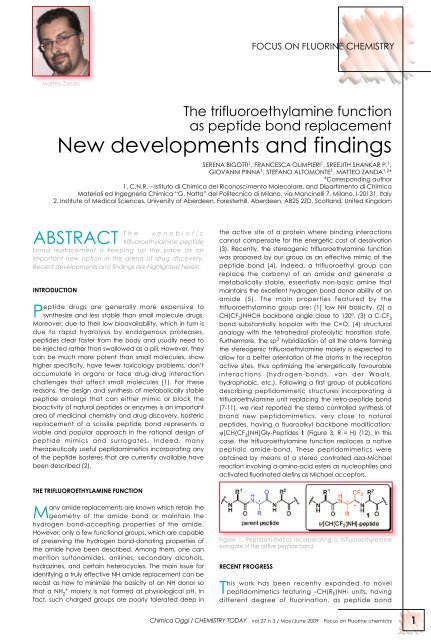
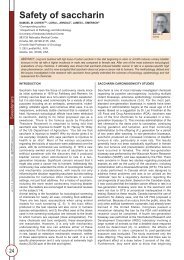
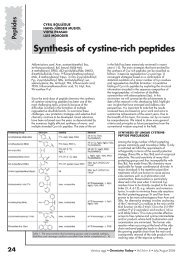
![Pietro Delogu [modalità compatibilità]](https://img.yumpu.com/12255149/1/190x135/pietro-delogu-modalita-compatibilita.jpg?quality=85)
